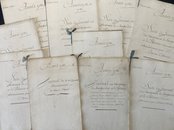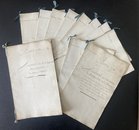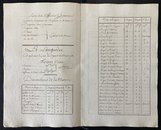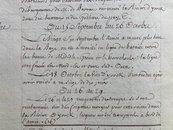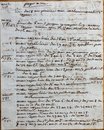Journal des vaisseaux le Languedoc, c.1781-82
[WAR OF AMERICAN INDEPENDENCE] ARROS D’ARGELOS (Jean-François, baron d’)]. Année 1781 [-1782]. Journal des vaisseaux le Languedoc et le Palmier commandés alternativement par Jean-François Baron D’Arros, Capitaine des Vaisseaux du Roi et Brigadier de ses Armées dans l’Armée aux ordres de M. le Comte de Grasse en Amérique ; avec des Nottes [in 10 vols.].
[followed by:] Avril 1782. Journal du 8 au 13 inclusivement. [1 vol.].
Manuscript in French. S.l., [c. 1783].
Folio. (32.2 x 20.5 cm). [220] pp., in 11 cahiers or notebooks with ribbon ties, calligraphic titles, housed in a modern red morocco box, in imitation of the period, with smooth gilt spine, title labels, etc. Some soiling to the first page of two of the notebooks, otherwise a wonderfully preserved set. Laid in: one folded sheet (22.5 x 18 cm) with 2 pp. of manuscript notes indicating significant passages in the journal.
Notebooks 1-10 make up the chronological journal of Captain d’Arros, an account of the activities of the warships the Languedoc and the Palmier from March 22, 1781 (departure from Brest) until September 8, 1782 (end of the campaign). Written on 18th century Dutch paper watermarked with the “Pro Patria” emblem and “J Kool” countermark.
Notebook 11, which is a summary of the dramatic events April 8-13, 1782, compiles the details described in the main sequence, into one tidy volume—very likely in preparation for d’Arros’s defense. The text of notebook 11 varies only slightly in the phrasing of the sentences and the word choice (for example, the pronoun “nous [we]” is preferred over the less formal “on [one]”. Equally legible, it is presented in a more condensed form, that is, in notebook 11, the same number of words cover a fewer number of pages. Notebook 11 is written on the same Pro Patria paper stock as the first 10 notebooks, and in what appears to be the same hand, and thus contemporaneous.
Captain d’Arros accused and acquitted:
The events described in notebook 11 are particularly important as they cover the famous Battle of the Saintes, south of Guadeloupe, after which the French Admiral, the Comte de Grasse was taken prisoner by Admiral Rodney. After this battle, de Grasse sought to place the responsibility for the failure on his officers who subsequently appeared before the Conseil de Guerre which met in Lorient, Sept. 20, 1783 – May 21, 1784, where Arros was accused of failing to do his duty. The court acquitted him of any wrongdoing.[i] Presumably these notebooks were part of d’Arros defense, with the more compact notebook 11, describing the April events, was prepared as an extra measure or back-up document that touched on the Battle of the Saintes.
Laid in: one folded sheet (22.5 x 18 cm, leaf size) with 2 pp. of manuscript notes—in a different hand—indicating significant passages in the journal that are to be read more closely. The document is neatly prepared and reads as a guide to sections of the notebooks.
Born in 1730 in Arthès in Béarn, and belonging to an important family of soldiers and sailors, Jean-François d’Arros entered the navy in 1744, became a lieutenant in 1756, then a captain in 1772. After having carried out numerous campaigns, notably in the West Indies and the Ile de France, he received, in 1780, the command of the Languedoc vessel of 80 guns, which the following year joined the squadron led by the Comte de Grasse.
The squadron, composed of 36 warships, was to “operate in America”, i.e., fight the English fleet which threatened the American revolutionaries. This manuscript covers the period from March 22, 1781 (departure from Brest) until September 8, 1782 (end of the campaign). The work is neatly presented and organized on the page, and written in a highly legible hand; it recounts in great detail the operations of the Languedoc in the United States (Chesapeake Bay) and the West Indies (Martinique, Les Saintes).
The diary of d’Arros opens with the list of the staff of the Languedoc: in addition to the captain, this included 4 lieutenants, 5 ensigns, 4 auxiliary officers and 7 infantry officers including Arros’s own son, a naval guard. Following that, technical information on the vessel: the dimensions of the rigging (masts and yardarms); then the ligne de bataille [battle fleet] divided into vanguard, battle corps, rear guard and light squadron, that is to say in all 25 vessels and 11 frigates, corvettes and flutes.
All nautical observations made on board are recorded: latitude, longitude, winds, condition of the sea, maneuvers of the various vessels, signals, etc. This diary was copied after the return of the expedition, very probably when d’Arros was preparing his defense before appearing before the court martial of Lorient, following the unfortunate affair of the Battle of the Saintes.
[i] “Décharge de toute accusation le sieur baron d’Arros capitaine de vaisseau commandant le Languedoc et supprime tous mémoires lettres écrits en ce qu ils contiennent d attentatoire à son honneur et à sa reputation.” The mention of “mémoires” is an allusion to a publication by the Comte de Grasse. (cf. Troude and Levot. Batailles navales de la France. Paris, 1867, V.2, pp. 159-160).
The squadron left Brest on March 22, 1781 and arrived in Martinique on April 28; the next day, they observed an English squadron that the Comte de Grasse did not want to attack: “On the twenty-ninth at daybreak, we saw the English army, numbering eighteen ships under Cap Salomon, Martinique. We formed the order of battle on the front line in the natural order… I fired several shots, my bolts [sic] did not reach the enemy… I arrived and steered on the tail of the English army, with the design of engaging in a general and decisive manner. In the midst of a maneuver which was leading us to victory, I was stopped by a cruel signal, which ordered me to hold the wind. I obeyed not without murmuring... M. de Grasse no doubt wanted to protect our convoy. The best way to protect it was to beat the enemy. He would have defeated them if he had not given me the signal to hold the wind” (2nd notebook, May 28-1).[i]
After a few weeks of maneuvers and pursuits by the English squadron, notably off Martinique and the island of Tabago, d’Arros received the order to take command of the Palmier, a 74-gun vessel, and to leave that of Languedoc to M. de Monteil (July 21, 1781). The squadron then headed for Chesapeake Bay, which it reached on August 30; the battle took place on September 5: “The enemy came at full sail downwind on us, formed on the nearest line on the port side with twenty-one ships; two of them three-deckers. They had six frigates or corvettes... At half past 3 the enemy vanguard arrived upon ours with the intention of fighting it… At 3h:55, the lead ships were ordered to run two quarters wide (marginal note: This order was too late: besides, instead of making them run at two quarters, it was necessary to have them by four and force them with sails. M. de Grasse alone is reprehensible for this fault relating to the conduct of the armies and against all the principles of tactics. The enemy then taking advantage of the disorder of our advanced guard, attacked it and the combat began at four o’clock very briskly. A few ships of our vanguard were forced to suffer broadsides in the flank, arriving to rally at the main battle. At half past four our corps battleships began the fire: the English having run wide to rally their vanguard… A vessel with three decks followed by two other lesser ones, arrived on me and cannonaded me with all their might for a whole hour. I did not fire until their cannonballs came on board; so I gave the order to fire… The fight lasted until half past six in the evening, and did not cease, so to speak, until nightfall. I received several cannonballs on board which damaged the sails: but fortunately no one was killed. As night fell...the two armies watched each other...Some of our vanguard ships had also been abused. The Diademe and the Cato signaled for aid: the former having her rudder damaged and her sails riddled. The second of the taking water; the St Esprit and the Pluton had their masts very damaged...”[ii] (4th notebook, from September 1 to 5, 1781).
[i] Le vingt-neuf au point du jour, on apperçut l’armée anglaise, au nombre de dix-huit vaisseaux de ligne sous le Cap Salomon, Isle de le, Martinique. Nous formames l’ordre de bataille sur la ligne de front dans l’ordre naturel… Je tirai plusieurs coups, mes bouloient (sic) n’atteignoient point l’enemi… je fais arriver et gouverner sur la queue de l’armée anglaise, dans le dessein d’engager une affaire générale et décisive. Au milieu d’une manoeuvre qui nous menoit à la victoire, je suis arrêté par un signal cruel, qui m’ordonne de tenir le vent. J’obéis non pas sans murmurer… M. de Grasse vouloit sans doute conserver le convoi. Le meilleur moyen de le protéger étoit de battre les énemis. Il les auroit vaincus s’il ne m’avoit pas fait le signal de tenir le vent.
[ii] L’énemi venoit à toutes voiles vent arrière sur nous, formés sur la ligne du plus près bâbord avec vingt un vaisseaux de ligne ; dont deux à trois ponts. Ils avoient six frégates ou corvettes… A trois heures et demie l’avant garde énemie a arrivé sur la nôtre dans l’intention d la combattre… À trois heures cinquante cinq minutes, ordre aux vaisseaux de tète de courir deux quarts largue (note marginale : Cet ordre a été trop tardif : d’ailleurs au lieu de les faire arriver de deux quarts, il falloit que ce fut de quatre et les faire forcer de voiles. M. de Grasse est seul répréhensible de cette faute relative à la conduite des armées et contre tous les principes de tactique). L’enemi profitant alors du desordre de notre avant garde, l’a attaqué et le combat a commencé à quatre heures très vivement. Quelques vaisseaux de notre avant garde ont été contraints d’essuyer des bordées dans la hanche, en arrivant pour se rallier au corps de bataille. À quatre heures et demie notre corps de bataille a commencé le feu : les Anglais ayant couru largue pour se rallier à leur avant garde… Un vaisseau à trois ponts suivi de deux autres moindres, ont arrivé sur moi et m’ont canoné de toutes leurs forces pendant une heure entière. Je n’ai point fait tirer, que lorsque leurs boulets sont venus à bord ; alors j’ai donné l’ordre de faire feu… Le combat a duré jusqu’à six heures et demie du soir, et n’a cessé pour ainsi dire qu’avec le jour. J’ai reçu plusieurs boulets à bord qui ont avarié les voiles : mais heureusement que nous n’avons eu personne de tué. À l’entrée de la nuit… les deux armées se sont observées mutuellement… Quelques uns de nos vaisseaux de l’avant garde ont aussi été maltraités. Le “Diadème” et le “Caton” ont demandé du secours : le premier ayant son gouvernail endommagé et ses voiles criblées. Le second des voyes d’eau ; le “St Esprit” et le “Pluton” ont eu leurs matures très endommagées…
Other battles took place, conjointly with the squadron commanded by the Comte de Barras, which de Grasse had rallied; the latter had landed Rochambeau’s army a few months earlier in Rhode Island, and participated in the siege of Yorktown by bringing reinforcements and artillery. These operations caused the capitulation of the English troops commanded by General Cornwallis (September 1781). On October 18, 1781, d’Arros was able to announce that the “city of York (Yorktown) had surrendered after having withstood a siege of ten days” (4th notebook, from October 15 to 26).
The following month, de Grasse’s squadron returned to Martinique where it engaged in other combat operations. In April 1782, the famous Battle of the Saintes, south of Guadeloupe, took place, following which the Comte de Grasse was taken prisoner by Admiral Rodney: “We shared... the pain of seeing our general surrender his vessel (the Ville de Paris), which still had all its masts upright and its yards in place... Crushed as we were, we could barely maneuver to avoid being enfiladed by the enemy vessels which were chasing us very close”[i] (6th notebook, from April 12 to 13, 1782).
D’Arros adds “The enemy did not seem satisfied with the general’s capture, they were still pursuing us with the same heat, they formed their line of battle, starboard and port side of us, squeezing us very closely, which forced me to fire from both sides… The enemy ended the fight at a quarter past seven… This is how that unfortunate day ended, famous for the capture of the chief and three vessels of seventy-four with one of sixty-four (guns)”[ii] (idem).
After this battle, de Grasse sought to place the responsibility for the failure on his officers who went before the Conseil de Guerre at Lorient. Arros d’Argelos, whose ship was among those which had stood firm with the Ville de Paris, was acquitted as having perfectly fulfilled his duty as a sailor. In 1784, d’Arros would be appointed squadron commander, while the Comte de Grasse would no longer serve as a commander at sea.
Dictionnaire de biographie française III, 1103 (d’Arros) ; Taillemite, Dictionnaire des marins français, pp. 222-223 (de Grasse), pp. 28-29 (Barras) and p. 377 (Monteil). Batailles navales de la France, v.2, pp.159-60.
[i] Nous partageâmes… la douleur de voir notre général rendre son vaisseau (le “Ville de Paris”), qui avoit encore tous ses mâts debout et ses vergues en place… Ecrasés comme nous étions, nous pouvions à peine manoeuvrer pour éviter d’être enfilés par les vaisseaux énemis qui nous chassoient de très près.
[ii] L’énemi ne paroissoit pas content de la prise du général, il nous poursuivoittoujours avec la même chaleur, il forma sa ligne de bataille, stribord et babord de nous, en nous serrant de très près, ce qui m’a obligé de faire feu des deux bords… L’énemi a fini le combat à sept heures trois quarts… C’est ainsi qu’a fini ce jour malheureux, fameux par la prise du chef et de trois vaisseaux de soixante quatorze avec un de soixante quatre (canons).
Description: Journal des vaisseaux Languedoc
